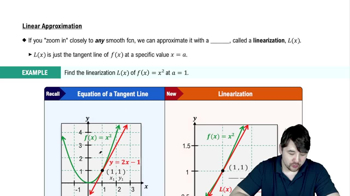Table of contents
- 0. Functions7h 52m
- Introduction to Functions16m
- Piecewise Functions10m
- Properties of Functions9m
- Common Functions1h 8m
- Transformations5m
- Combining Functions27m
- Exponent rules32m
- Exponential Functions28m
- Logarithmic Functions24m
- Properties of Logarithms34m
- Exponential & Logarithmic Equations35m
- Introduction to Trigonometric Functions38m
- Graphs of Trigonometric Functions44m
- Trigonometric Identities47m
- Inverse Trigonometric Functions48m
- 1. Limits and Continuity2h 2m
- 2. Intro to Derivatives1h 33m
- 3. Techniques of Differentiation3h 18m
- 4. Applications of Derivatives2h 38m
- 5. Graphical Applications of Derivatives6h 2m
- 6. Derivatives of Inverse, Exponential, & Logarithmic Functions2h 37m
- 7. Antiderivatives & Indefinite Integrals1h 26m
- 8. Definite Integrals3h 25m
4. Applications of Derivatives
Linearization
Problem 4.R.45
Textbook Question
45–46. Linear approximation
a. Find the linear approximation to f at the given point a.
b. Use your answer from part (a) to estimate the given function value. Does your approximation underestimate or overestimate the exact function value?
ƒ(x) = x²⸍³ ; a =27; ƒ(29)
 Verified step by step guidance
Verified step by step guidance1
Identify the function f(x) = x^(2/3) and the point a = 27 where you will find the linear approximation.
Calculate the derivative f'(x) using the power rule: f'(x) = (2/3)x^(-1/3).
Evaluate the derivative at the point a = 27 to find f'(27).
Use the point-slope form of the linear approximation: L(x) = f(a) + f'(a)(x - a), substituting in the values of f(27) and f'(27).
Substitute x = 29 into the linear approximation L(x) to estimate the value of f(29) and compare it to the actual value of f(29) to determine if it underestimates or overestimates.
Was this helpful?
Related Videos
Related Practice




